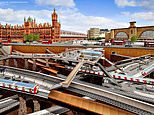
It’s London as you’ve never seen it before.
That is unless you have X-ray vision.
These fascinating illustrations peel back the exteriors of some of the capital’s most instantly recognisable buildings to reveal a fascinating cross-section of the interior.
The buildings featured include the Elizabeth Tower, which houses Big Ben and a little known prison, and King’s Cross St. Pancras Underground Station, which contains layers of Tube tracks. The illustrations also reveal the maze of walkways and stairwells that make up London’s Barbican Centre – home to the London Symphony Orchestra – and the suite of opulent rooms hidden inside 10 Downing Street.
Researchers, including architect Laurentiu Stanciu, painstakingly studied images and floor plans in order to create an accurate representation of the inside of each landmark.
Scroll down to take a step inside some of London’s most famous buildings…
The Barbican Centre
The Barbican Centre is a performing arts centre in the Barbican Estate of the City of London and the largest of its kind in Europe. The building had a long development period, with construction beginning in 1971 and not being completed until 1981. The Barbican opened in 1982 after the surrounding Barbican Estate housing complex had been built. It is home to the world renowned London Symphony Orchestra
Some ingenuity was needed to fit the arts centre into the restricted site. The Barbican’s website explains: ‘The architects and engineers resorted to an ingenious solution – to excavate the site 20 metres below ground level and place the majority of the centre below the elevated walkways or “podium” level. The architects compared the arts centre to “the hull of a large ship in which much is contained below the water”.’ Inside visitors experience a kind of puzzle, with levels at multiple heights interlocking via semi-exposed walkways and stairwells
Elizabeth Tower
Although often referred to as Big Ben, this famous London landmark is actually called the Elizabeth Tower. Big Ben is the 15-ton bell that sits inside the clock tower. Construction started on the tower in 1844 and it was designed by Charles Barry and Augustus Pugin. It opened on May 31, 1859. In addition to the clock, the tower boasts a prison room specifically intended for politicians from the Houses of Parliament next door. Its last involuntary guest was MP Charles Bradlaugh in 1880
Other features across the tower’s eleven floors include a mini museum, a storeroom, and 334 steps (plus another 59 to the Ayrton Light, which comes on when parliament is in session)
The O2 Arena
Formerly known as the Millennium Dome, the O2 Arena is the planet’s largest supported dome and is now a multi-purpose indoor arena located on the Greenwich Peninsula in south east London. Originally designed for a year-long Festival of Britain-style series of exhibitions and experiences, the structure was re-purposed into an arena from 2003 to 2007. It has the second highest seating capacity of any indoor venue in the United Kingdom, and took the crown of the world’s busiest music arena from New York City’s Madison Square Garden in 2008
The O2’s super-thin glass fibre fabric is pinned to supporting cables by over 20,000 clamps and the 100-metre masts that hold it up are what disqualify the structure from being a true dome in architectural terms
King’s Cross St Pancras Underground Station
Few hubs are as busy or as expansive as King’s Cross St Pancras, a London Underground station on Euston Road in the Borough of Camden. Construction of the station began in 1851 and the station was one of the first to open on the network in 1863. As of 2017, it is the most used station on the network for passenger entrances and exits combined
When the original station opened, its twin 800ft train sheds were praised for their simplicity. But high demand has required major overhauls over recent decades. The new steel and glass Western Concourse was part of a £500million redevelopment ahead of the 2012 Olympics
Royal Opera House
The Royal Opera House is a major performing arts venue in Covent Garden, Central London. The façade, foyer, and auditorium date from 1858, but almost every other element of the present complex dates from an extensive reconstruction costing £178million in the 1990s
During the renovation in the 1990s, the Floral Hall, left, an iron and glass structure designed by E.M. Barry as both a flower market and ballroom, was transformed from its distinctly fading glory into a new social space with bars and eateries
10 Downing Street
The headquarters of the UK government and official residence of the Prime Minister, Number 10 actually comprises three separate 17th century buildings, which have since been connected. This cutaway shows a suite of drawing rooms on the first floor, with offices and the PM’s meeting room/den below. All in all, the building contains around 100 rooms – hardly the modest terraced house it appears from the front
The unassuming facade of Downing Street. The buildings that make up the street were built over two years from 1682 to 1684. One of the building’s biographers wrote: ‘The scene of hundreds of years of top-level decision-making, it is also the product of hundreds of years of incremental adaptations, repairs and restorations… much about No.10 is the product of historical chance rather than design’
Source link
CHECK OUT: Top Travel Destinations
READ MORE: Travel News



